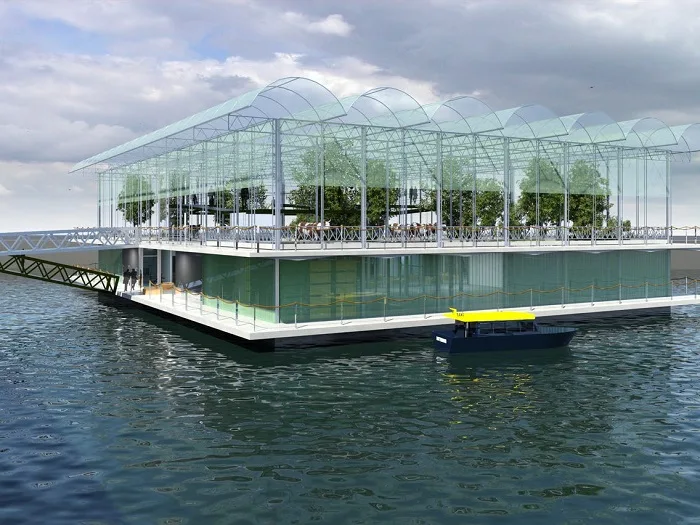Floating Farms: A Revolutionary Solution for Sustainable Agriculture

In the quest to address the growing global demand for food, floating farms have emerged as a pioneering technology offering a sustainable and innovative approach to agriculture. This article delves into the concept of floating farms, tracing their origins, exploring their unique features, discussing the challenges of implementation, evaluating their effectiveness, and considering their potential to combat global hunger.
What is Floating Farm Technology and When Did It Appear?
Floating farms are an innovative form of agriculture that operate on water bodies, utilizing the surface of lakes, rivers, or coastal areas to grow crops and rear livestock. The concept of floating farms is not entirely new, as traditional floating gardens have been used for centuries in regions like Myanmar’s Inle Lake and Bangladesh. However, the modern incarnation of floating farms, equipped with advanced technology and sustainable practices, began to take shape in the early 21st century.
The first modern floating farm was established in the Netherlands in 2018 by the company Beladon. This project, located in Rotterdam’s harbour, is a floating dairy farm designed to produce fresh milk in an urban environment while addressing issues such as land scarcity and the environmental impact of traditional farming methods. This innovative approach has since inspired similar projects worldwide, aiming to make agriculture more resilient to climate change and urban expansion.
What are the Features of Floating Farms?
Floating farms stand out for their ability to integrate advanced technologies and sustainable practices in an aquatic environment. One of the key features is the use of hydroponics and aquaponics systems, which allow for soil-less cultivation of plants using nutrient-rich water. Aquaponics combines fish farming with hydroponics, creating a symbiotic environment where fish waste provides nutrients for plants, and plants help to filter and clean the water for the fish.
Additionally, many floating farms incorporate renewable energy sources such as solar panels and wind turbines to power their operations, reducing reliance on fossil fuels and minimizing the carbon footprint. Advanced waste management systems are implemented to recycle nutrients and water, ensuring minimal environmental impact. Furthermore, floating farms can be relocated as needed, allowing them to adapt to changing environmental conditions and urban development. This flexibility also enables the farms to be positioned close to urban centers, reducing transportation costs and ensuring fresh produce is readily available to city dwellers.
How Difficult is it to Implement Floating Farms?
Implementing floating farms involves several challenges, both technical and logistical. One of the primary difficulties is the initial cost of setting up the infrastructure, which can be significantly higher than traditional farming. This includes the construction of floating platforms, installation of hydroponic or aquaponic systems, and the integration of renewable energy sources. Additionally, floating farms require careful site selection to ensure water quality and stability, as well as compliance with local regulations and environmental standards.
What is the Effectiveness of Floating Farms?
The effectiveness of floating farms can be measured through various parameters, including productivity, environmental impact, and economic viability. Floating farms have demonstrated high productivity levels due to the controlled growing environment and efficient use of resources. For instance, hydroponic systems can yield up to 30% more produce compared to traditional soil-based farming. Additionally, aquaponic systems offer the dual benefit of fish and crop production, maximizing the output from a single platform.
Floating farms significantly reduce the environmental footprint of agriculture. By utilizing renewable energy sources and advanced waste management systems, they minimize greenhouse gas emissions and water pollution. Moreover, floating farms do not require deforestation or conversion of natural habitats into agricultural land, preserving biodiversity. While the initial setup cost is high, the long-term economic benefits of floating farms are promising. Reduced transportation costs, higher yield per unit area, and the potential for year-round production contribute to the economic feasibility of these systems. Additionally, floating farms can create new job opportunities and stimulate local economies.
Furthermore, floating farms are inherently more resilient to climate change impacts such as floods, droughts, and rising sea levels. Their ability to float on water bodies ensures they remain operational even during extreme weather events, providing a stable food supply in times of crisis.

Can Floating Farms Solve the Problem of Hunger?
Floating farms have the potential to play a significant role in addressing global hunger by providing a sustainable and resilient food production system. However, their ability to solve the problem of hunger depends on several factors. To make a meaningful impact on global food security, floating farms must be scalable and accessible to communities worldwide. This requires investment in research and development to reduce costs and improve the efficiency of these systems.
Government policies and incentives can accelerate the adoption of floating farms by providing funding, technical support, and regulatory frameworks that promote sustainable agriculture. International cooperation and knowledge sharing are also crucial to the widespread implementation of floating farms. Engaging local communities in the planning and operation of floating farms is essential for their success. Education and training programs can empower individuals to participate in and benefit from these innovative agricultural practices, ensuring that the technology is used effectively and sustainably.
In conclusion, while floating farms alone may not completely solve the problem of global hunger, they represent a vital component of a multifaceted approach to sustainable food production. By integrating advanced technologies, promoting environmental stewardship, and fostering community involvement, floating farms can contribute significantly to a more food-secure future.
